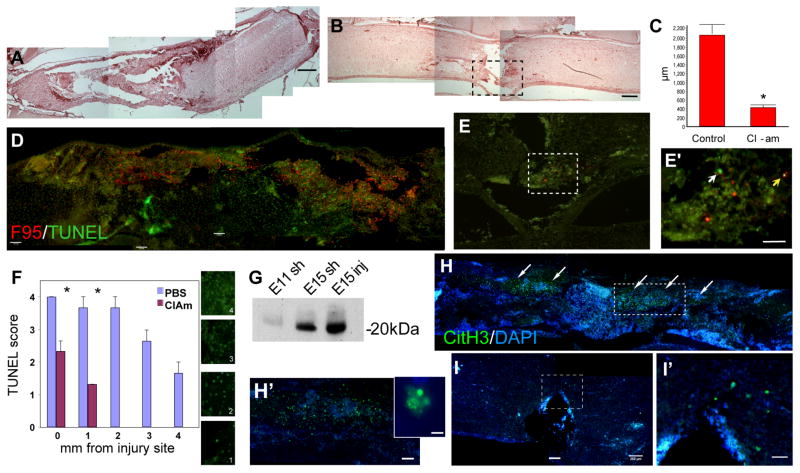Figure 6.
Effect of Cl-amidine treatment on E15 chick spinal cords 24 hours after injury assessed by hematoxylin and eosin staining (A–B), co-labelling for deiminated proteins with the F95 antibody and for apoptosis by TUNEL (D–E), and staining for deiminated H3 (H–I′). A) Control spinal cord injury; note large cavity. B) Injured spinal cord treated with 80 mg/Kg Cl-amidine; note the reduction in cavity size. C) Quantitative analysis of cavity size (n=6; m±sd); note significant reduction (ANOVA, p≤0.001) following Cl-amidine treatment. D) F95 (red) and TUNEL (green) labelling of injured control spinal cord; note extensive deimination and apoptosis. E) F95 (red) and TUNEL (green) labelling of injured Cl-amidine-treated spinal cord. E′) Higher magnification of the dotted box in (E); note the reduction in both deimination and apoptosis in the treated spinal cord; the white arrowhead points to an apoptotic cell and the yellow arrow to a cell double-labelled for TUNEL and F95. F) Density of TUNEL-positive cells in control and Cl-amidine-treated animals scored at different distances from the injury (n=4; m±sd). The boxes indicate the scoring criteria used to evaluate the extent of apoptosis from very low/negative (1) to high (4). Note significant reduction (* p≤0.04; Student’s t-test) following Cl-amidine treatment close to the injury side and absence of TUNEL-positive cells from 2 mm from the injury site in Cl-amidine-treated spinal cords. G) Western blot detecting histone 3 (H3) in immunoprecipitated deiminated protein fractions from 1) E11 sham-operated, 2) E15 sham-operated and E15 injured spinal cords. H) Control injured spinal cord; deiminated H3 (CitH3, green) is detected in the injured region in E15 spinal cords (arrows) and commonly associated with nuclei of apoptotic morphology (see insert). I–I′) Cl-amidine-treated injured spinal cord; note greatly decreased expression of CitH3 around the injury site (box enlarged in I′) compared to (H–H′). Scale bars = 260 μm (A,B,D,H,I); 130 μm (E); 65 μm (E′, I′), 20 μm (insert in H).

